The HTC One (M8) Review
by Anand Lal Shimpi & Joshua Ho on March 26, 2014 7:00 PM EST- Posted in
- Smartphones
- HTC
- Mobile
- HTC One
Snapdragon 801 Performance
The M8 is the first smartphone we’ve tested to use Qualcomm’s newly announced Snapdragon 801 SoC. At a high level the 801 is a frequency bump enabled by a 28nm HPm process push, giving it a tangible increase in performance (and potential decrease in power consumption) compared to the outgoing Snapdragon 800. The table below compares the 801 variants to the Snapdragon 800:
| Snapdragon 800/801 Breakdown | ||||||||||
| SoC Version | Model | Max CPU Frequency | Max GPU Frequency | ISP | eMMC | DSDA | Memory IF | |||
| MSM8974VV | v2 | S800 | 2.2GHz | 450MHz | 320MHz | 4.5 | N | 800MHz | ||
| MSM8974AA | v2 | S800 | 2.3GHz | 450MHz | 320MHz | 4.5 | N | 800MHz | ||
| MSM8974AB | v2 | S800 | 2.3GHz | 550MHz | 320MHz | 4.5 | N | 933MHz | ||
| MSM8974AA | v3 | S801 | 2.3GHz | 450MHz | 320MHz | 5.0 | Y | 800MHz | ||
| MSM8974AB | v3 | S801 | 2.3GHz | 578MHz | 465MHz | 5.0 | Y | 933MHz | ||
| MSM8974AC | v3 | S801 | 2.5GHz | 578MHz | 465MHz | 5.0 | Y | 933MHz | ||
In most parts of the world the M8 will ship with a 2.3GHz Snapdragon 801. In Asia/China however we’ll see the 2.5GHz MSM8974AC v3 SKU instead.
Compared to the outgoing Snapdragon 800, peak CPU performance shouldn’t increase all that much. What we may see however is an improvement in power efficiency thanks to the improved 28nm HPm process.
It’s really the GPU that will see the largest increase in performance. With a maximum speed of 578MHz and paired with faster LPDDR3-1866 memory, we should see up to a 30% increase in GPU bound performance over Snapdragon 800 designs.
- Physics
| Snapdragon 801 vs 800 vs 600 | |||||||
| HTC One (M8) - Snapdragon 801 | Google Nexus 5 - Snapdragon 800 | HTC One (M7) - Snapdragon 600 | 801 vs 800 | 801 vs 600 | |||
| SunSpider 1.0.2 | 772.8 ms | 686.9 ms | 1234.8 ms | -12% | +37% | ||
| Kraken Benchmark 1.1 | 6745.2 ms | 7245.9 ms | 12166.5 ms | +7.4% | +45% | ||
| Google Octane v2 | 4316 | 3726 | 3103 | +16% | +39% | ||
| WebXPRT Overall | 373 | 392 | 244 | -5% | +53% | ||
| AndEBench - Native | 17430 | 17480 | 12381 | -1% | +41% | ||
| 3DMark 1.1 Ultimate | 19631 | 17529 | 10519 | +12% | +87% | ||
| 3DMark 1.1 Ultimate - Physics | 50.5 | 51 | 33.1 | -1% | +53% | ||
| Basemark X 1.1 - HQ | 12194 | 11275 | 4807 | +8.1% | +154% | ||
| GFXBench 3.0 - Manhattan Onscreen | 11.1 fps | 9.3 fps | 5.1 fps | +19% | +118% | ||
| GFXBench 3.0 - Manhattan Offscreen | 10.4 fps | 8.7 fps | 4.4 fps | +20% | +136% | ||
| GFXBench 3.0 - T-Rex HD Onscreen | 29.9 fps | 24.3 fps | 12.6 fps | +23% | +137% | ||
| GFXBench 3.0 - T-Rex HD Offscreen | 27.9 fps | 22.9 fps | 12.6 fps | +22% | +121% | ||
CPU Performance
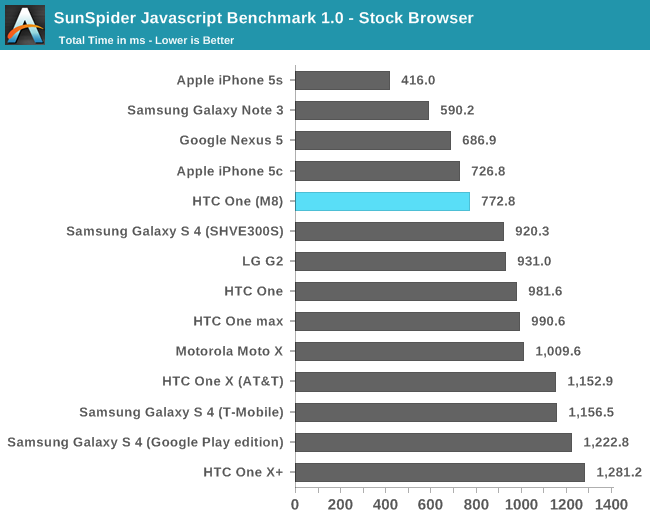
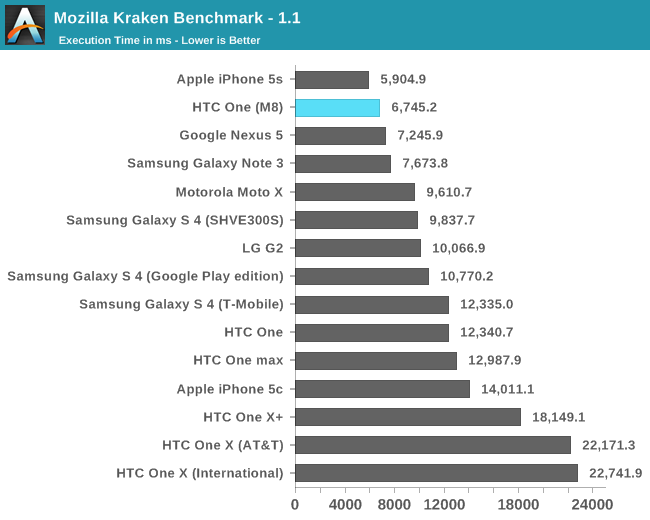
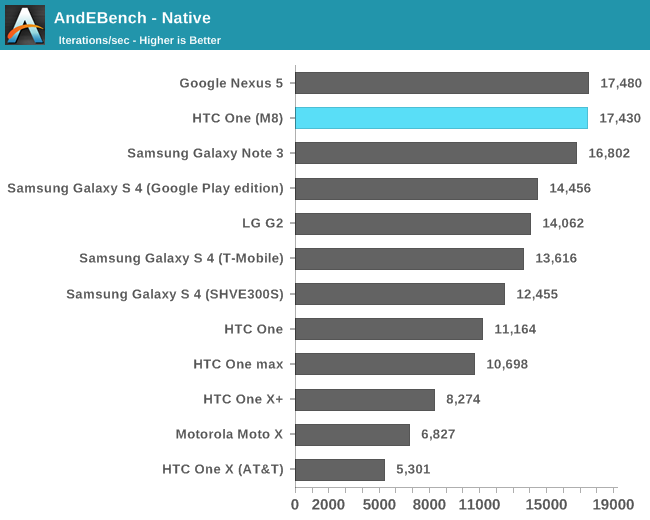
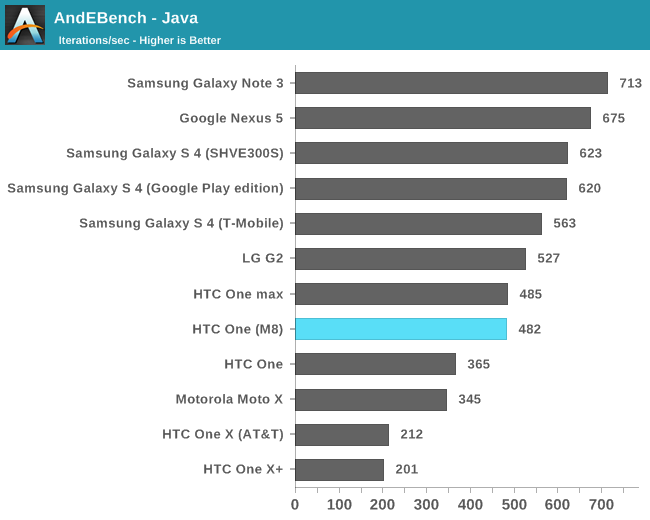
GPU Performance
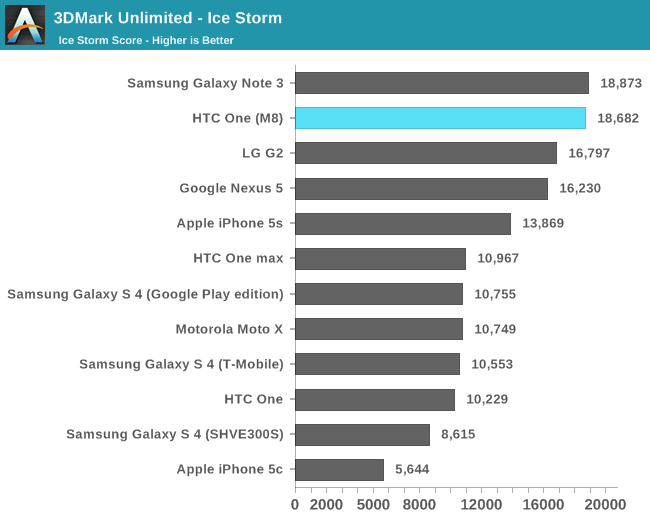
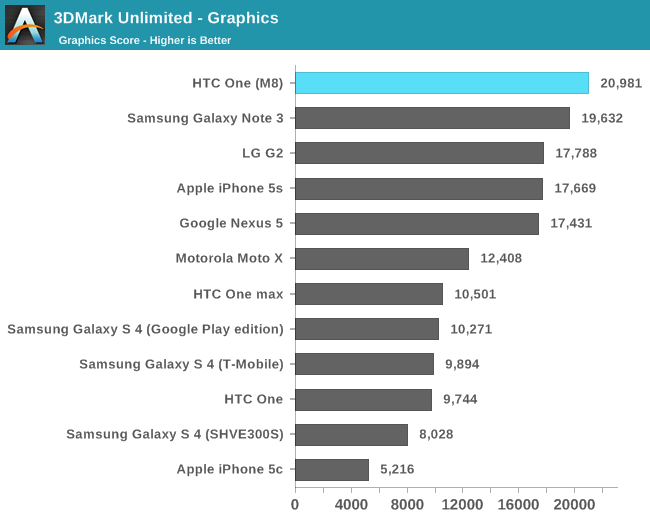
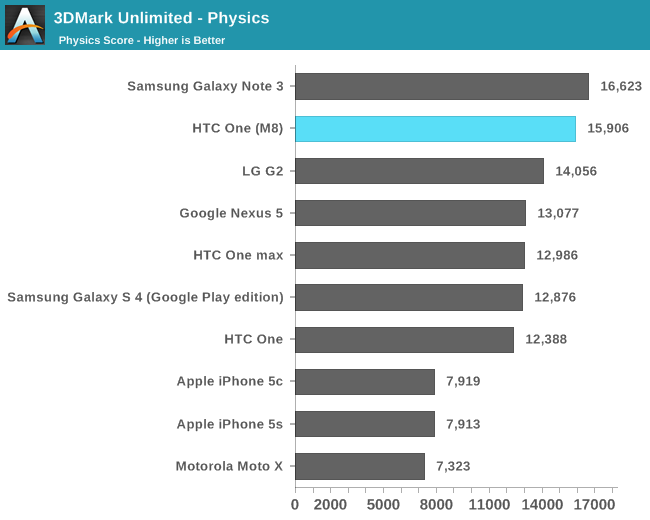
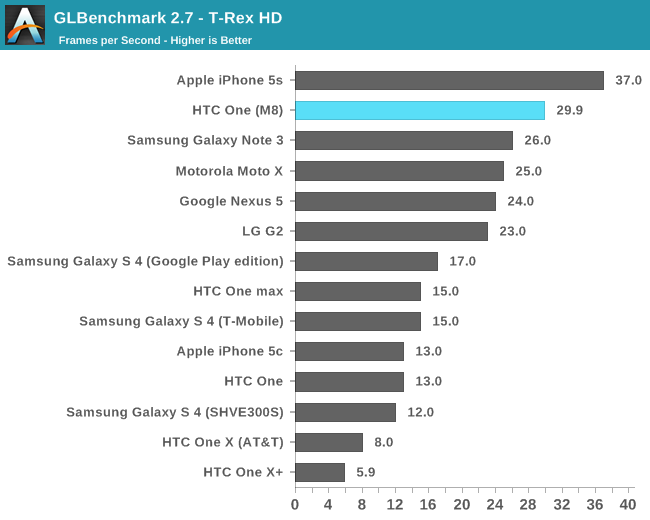
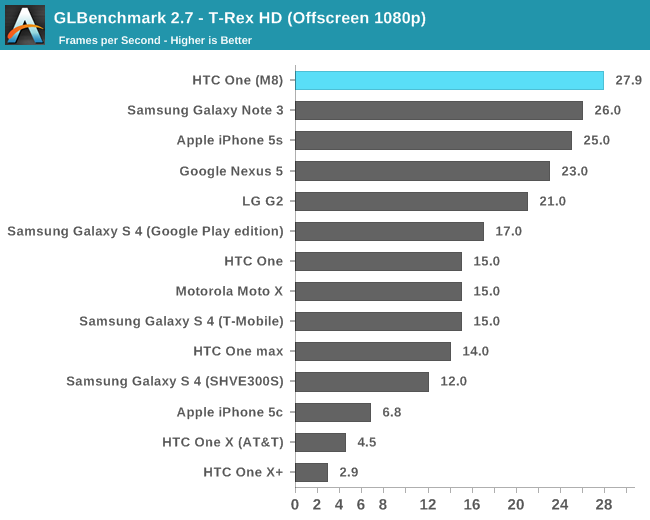
NAND Performance
The One is available in either 16GB or 32GB configurations, there are no higher capacity versions offered. There is now a micro SD card slot on the right side of the device, just above the volume rocker.
Despite using a Snapdragon 801 SoC, the internal storage is still an eMMC 4.5 solution.
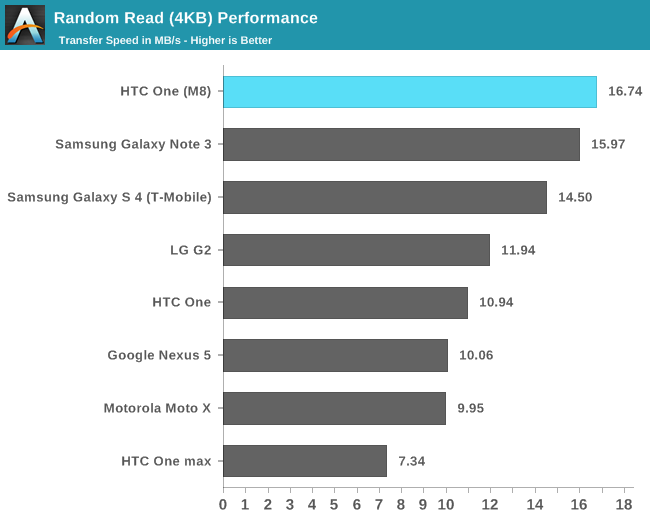
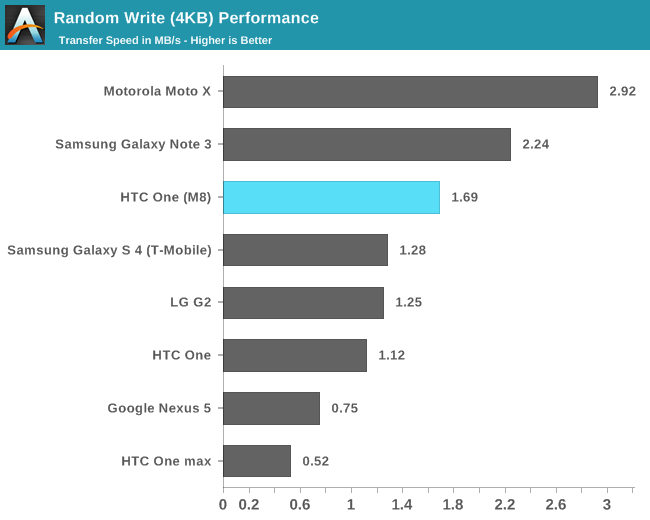

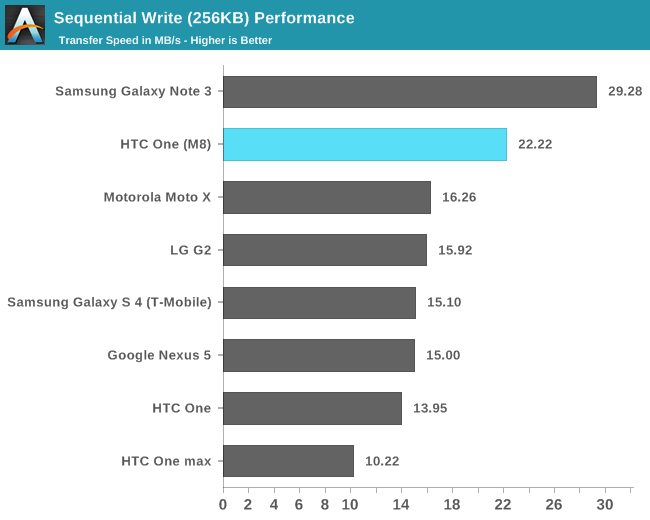


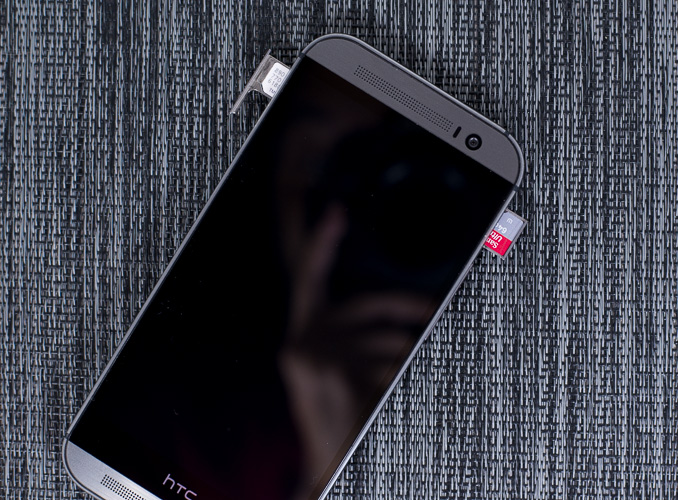








222 Comments
View All Comments
althaz - Wednesday, March 26, 2014 - link
Why are the OLED screens not listed in the brightness for black and contrast tables? Yes, they have zero black levels and infinite contrast, but that's the level LCDs should be aspiring to and it's worth comparing them, IMO.There's a reason most people go for OLED screens (despite almost every reviewer preferring LCDs), they have MUCH better contrast. IMO this is a serious flaw of all LCD phones and should be mentioned. Sure, the tradeoffs may well be worth the relatively poor contrast, but that's something each user has to decide for themselves.
Braumin - Wednesday, March 26, 2014 - link
There's not enough horizontal pixels to graph infinity.evonitzer - Saturday, March 29, 2014 - link
True, but it still seems like there should be some mention of that, or just putting them at the top a bit above the leader. When I was looking at HDTV's some years ago, black levels were of very high priority, hence me getting a plasma. To think we would have perfect blacks on phones and people would shrug just a few short years later ...hangfirew8 - Wednesday, March 26, 2014 - link
Great review, not enough reason to trade-up from my M7, especially given the OIS video difference.I'll repeat my request to review the matching car dock and car mode/launcher with each review. With so many places passing hands-off laws for drivers, this mode is more and more important, and is obviously not given enough attention by either OEM's or reviewers.
Besides car dock mode, I really think a BT test such be conducted against, say, a Pioneer, a Kenwood and some select factory auto receivers. Complaints about niggling sync or lag or other bugs are common, but if no one is reviewing these combinations systematically, the manufacturers of both the phones and the car audio systems are not going to do anything about it.
Think of it this way- many phones spend most of their screen-on operating time docked in a car dock or holder of some kind, and BT synced with the receiver. It is the second most common operating usage after sitting beside us on our desk or armchair.
SorryItsAThrowAway - Wednesday, March 26, 2014 - link
I disagree that Sense UI is the best experience "bar none." If you've only compared it to Samsung or LG - then, sure. That would be an obviously true statement. However other manufacturers have arguably far more usable designs. If we stay with the Western audience as this article so clearly does then the best examples would be Motorola recently and even more especially Sony.Even if these still somehow came up short to Sense (debatable) they are certainly not so far away from the strong wording this review claims.
dylan522p - Wednesday, March 26, 2014 - link
Moto isn't classified as a skin and Sony adds VERY VERY little features and a lot of pointless changes.SorryItsAThrowAway - Wednesday, March 26, 2014 - link
I disagree. If it isn't stock then it's a skin. Moto is very minimal. Sony as well but they also have an entire theme system to change things like the appearance of the on-screen interface buttons. So, Sony can go either way with that in mind (good or bad).rxzlmn - Wednesday, March 26, 2014 - link
That's wrong. Sony keeps the main UI elements all the same, but does add many little helpful things. But they don't change how things behave and look in terms of usability compared to stock (different from HTC, LG or Samsung).CoryWeston101 - Monday, March 31, 2014 - link
No. Sense is the best user experience and best UI. No other Android OEM comes close. Motorola's UI is just stock with some added stuff. And Sony has a good UI but it isn't better than Sense.icwhatudidthere - Wednesday, March 26, 2014 - link
Actually that photo of you in the bar is how normal bokeh would look as well. Everything in your plane should be in focus, in this case, the second sensor is doing its job correctly and rendering a more realistic bokeh instead of a software-only solution.There is one artifact though on the wall paneling close to the table. I guess they're not actually assigning depth values to individual pixels but grids instead for faster processing.